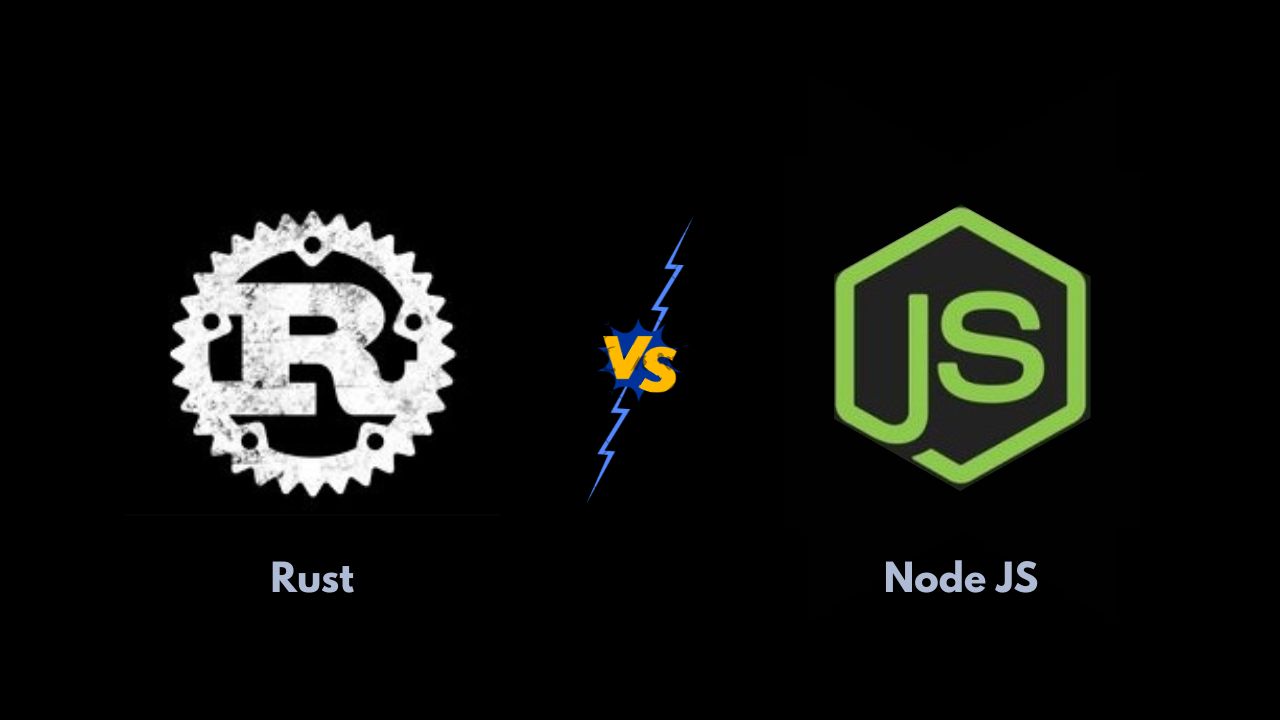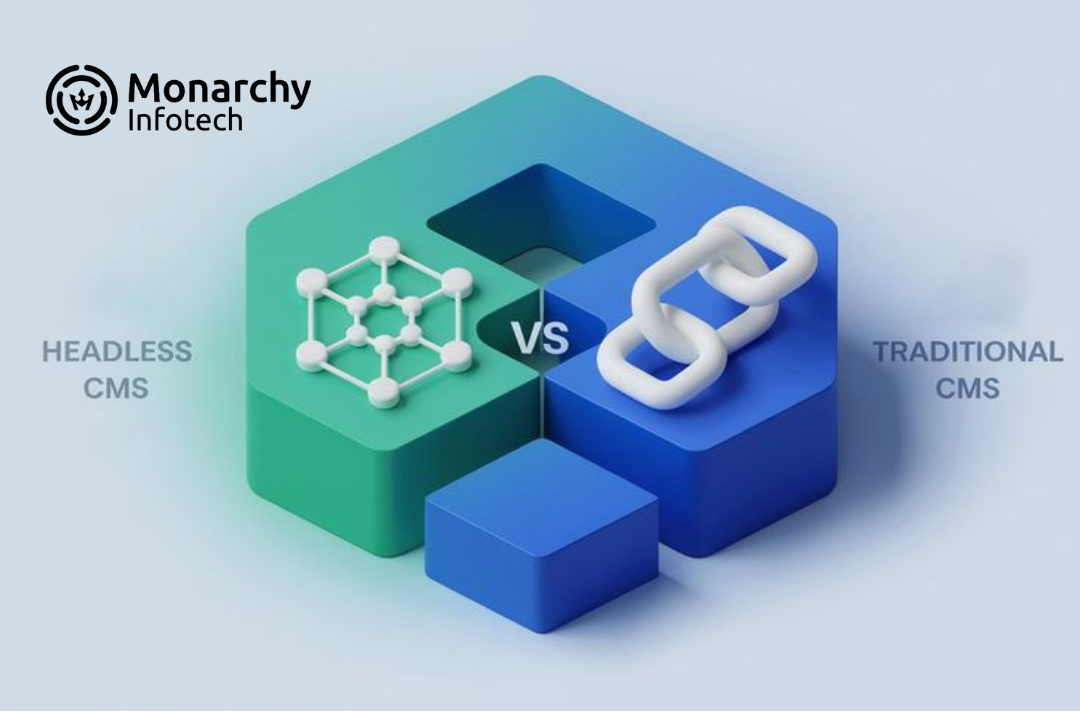Among the many options, Rust and NodeJS seem to be two popular backend technologies. It is important to note that the choice depends on the purpose of your application, and stability/performance requirements.

Rust Vs. Node JS
Rust vs Node.js: Which One is Best for Your Next Web Application?
Technological advancements and shifting industry trends are responsible for the evolving web applications development landscape. As more people access web applications, it has become important for businesses to invest in the asset. Standardized web app platforms.
API integrations to enhance functionality and modular architecture have made web development crucial for businesses. It improves the business’ visibility and has the ability to meet the changing experience requirements.
Choosing the appropriate tech stack is equally important in planning your upcoming web application project. While the frontend enhances the aesthetics, it is the backend that offers robustness and stability. It is the backend technology that plays a crucial role in ensuring smooth operations and quick queries.
Among the many options, Rust and NodeJS seem to be two popular backend technologies. It is important to note that the choice depends on the purpose of your application, and stability/performance requirements.
NodeJS is a popular framework among developers. A statistic from Statista
In this guide, we will discuss the two technologies in detail. Let’s look at the key features before conducting a head-on comparison.
Why Choose NodeJS for Web Applications?
We will begin our journey to discovering the frameworks with NodeJS. This is one of the finest web application backend development technologies that helps build robust solutions.
An Overview of NodeJS
NodeJs is a JavaScript-based server-side and open-source programming language that helps build robust and scalable applications. You can expect high-performance mobile solutions with this technology.
The programming language is built using the V8 JS engine and offers a non-blocking I/O model. You can easily build defined APIs and extensive real-time applications with this technology. You can easily install and run the NPM packages and start working with this technology.
Key Characteristics of NodeJS
Here are the features that you get with NodeJs
Real-time Applications: With NodeJs, you can build real-time applications. The event-driven architecture allows you to create more realistic and real-time communication between the interface and the backend.
NodeJs: Uses event-driven and non-blocking I/O, so it finishes one task before starting another. As a result, the applications built can easily handle multiple operations at a go. In case you plan an application with extensive I/O operations, you can use NodeJs.
Vibrant Ecosystem: This is one of the most extensive and highly active ecosystems. You will get all types of packages and third-party libraries needed to build your business app’s backend system. You will get an excellent share of utility libraries and database drivers to boost the business.
Single Language Stack: You need to download and install the single package management NPM. It is complete with third-party libraries and modules that help improve the app integrations. You can easily leverage the package to build robust applications.
Rapid Development with JavaScript: JavaScript has always been famous for frontend app development. You can easily leverage its interactive abilities and dynamism to build backend and highly efficient solutions.
Cross-Platform Compatibility: This backend technology has been crafted to boost the backend of your systems. You can easily use the technology across platforms and operating systems. You must write a single code and share it across devices.
Server-Side Rendering (SSR): This is specifically used to build server-side applications. You can easily handle multiple incoming requests and offer dynamic content to the users. It is a capable technology to foster full-stack development.
Microservices and API: It offers the appropriate functionality to deliver microservices architecture. You can also build RESTful APIs with this technology. Owing to its lightweight and efficiency with I/O, it can help deploy independent solutions and scale them effectively.
Why Choose Rust for Web Applications?
We have seen how NodeJs fares as a backend technology. Let’s quick look at another popular backend technology, Rust.
Overview of the Framework Rust
Rust is one of the popular systems programming languages renowned for offering high-performance and concurrency solutions. The main purpose of designing the language was to ensure it could handle the challenges that come with C and C++.
You get several modern features and can handle errors significantly with this framework. You can easily involve high-level abstractions without impacting the performance or speed of this framework. Moreover, it can handle dangling pointers and null pointer dereferences exceptionally well.
Let’s look at the key features of Rust that you must consider when choosing the framework.
Key Characteristics of Rust
Modern Web Frameworks: The technology supports some of the finest modern frameworks including Actix, Rocket and Warp. You can use these technologies to build robust and scalable applications with Rust. You can easily include features like routing and middleware when planning modern applications.
Strong Memory Safety and Performance: This framework extends memory safety, which allows you to scale the app without incorporating the vulnerabilities. You can use the ownership system and borrow checkers to handle memory issues like buffer overflow and dangling pointers.
WebAssembly (Wasm) Compatibility: You can compile it into a WebAssembly application. As a result, you can easily run them across web browsers. Owing to this compatibility, you can offload most of the heavy-weight and high-performance tasks to the interface side.
Minimal Runtime Dependencies: You don’t need to depend on the standard Rust libraries to build the application. You can easily create resources and embed systems that can help improve the application development.
Type System and Predictable Behavior: Framework has a type system that helps you debug the whole application at once. You can release a bug-free and high-quality app with minimal effort using this feature.
Long-Term Maintainability: Owing to the inherent borrowing and ownership system, you will notice that Rust produces error-free code. As a result, it will ensure that there are minimal bugs at runtime. Moreover, with memory safety and other features, you get an easy-to-maintain code. This will help developers ensure a smooth and long-running codebase.
NodeJS Vs Rust
It is important for you to understand the differences between the two technologies. When building your tech stack, you must be aware of your requirements. It is equally important to know which technology can fulfill your app’s backend needs better.
#1 Application Performance
NodeJs: As NodeJs works with a non-blocking and event-driven architecture, you will notice that it extends an excellent performance. You can simultaneously debug and load multiple queries.
Rust: You must compile the code to an efficient machine code with this language. As a result, it offers highly I/O-bound and compute-intensive tasks.
The Choice: If you want real-time and simultaneously loading app solutions, you can use NodeJs. NodeJs is best for high I/O performance. However, Rust can cater to your performance needs with high I/O and compute-intensive tasks.
#2 Developer’s learning curve
NodeJs: NodeJs is a JavaScript-based language. As a result, it is easy to learn and use. The only challenge would be when you are using asynchronous programming as that comes with a learning curve.
Rust: The technology comes with a new aspect known as the ownership and borrowing system. This can increase your developer’s learning curve. You might have to practice a bit and understand their detailed learning model before developing applications.
The Choice: Rust comes with a steeper learning curve owing to the development model. However, you might notice a low learning curve for NodeJs.
#3 Ecosystem and support
NodeJs: As it is a JavaScript-based backend technology, you will notice a highly mature ecosystem for NodeJs. Similarly, being one of the oldest languages, it offers a mature community backing your needs.
Rust: The ecosystem for this framework is still growing. It is not as mature or full as NodeJs. However, the focus lies on safe and reliable services, which makes the entire ecosystem structured.
The Choice: If you want an entire community’s support, you must choose NodeJs. However, if you are looking for a reliable and structured ecosystem, you can go with Rust.
#4 In-built libraries
NodeJs: When you install the NodeJs package, you get a complete and standard library at your disposal. It is complete with modules that can help you with networking and system operations.
Rust: You get a standard library. However, you will notice that there are fewer runtime dependencies in this case. As a result, you can always create new features in the application.
The Choice: Owing to several standard libraries and in-built code, you will notice that developers prefer NodeJs web development. It allows developers to create applications faster with the available code.
#5 Concurrency
NodeJs: You can easily create concurrency using the event loop and asynchronous programming. As a result, it can handle multiple operations simultaneously. It will not affect the performance and boost the speed of the applications.
Rust: You will get native-like support for both concurrency and parallelism with this technology. It comes with a strong ownership system that boosts concurrency.
The Choice: You can go with both Rust and NodeJs for concurrency needs. It is highly capable and can enhance the performance.
#6 Deployment
NodeJs: One of the main reasons to choose NodeJs is the easy deployment capabilities. You can easily launch your app while optimizing it for performance. You can use multiple deployment methods as well.
Rust: You will need to perform an extra step of compilation before your application is ready to be launched. Once the code is compiled, it is optimized for performance. As a result, you can launch without the need for a target system.
The Choice: NodeJs is easy to deploy technology. However, if you want to ensure launching the app without the need for a target system, you must use Rust for web development.
#7 Use Cases
NodeJs: You can create real-time applications, craft stable web servers and offer full-stack development with NodeJs.
Rust: You must use Rust for embedded development, high-performance apps and where memory safety is crucial for the developers.
The Choice: Depending on the concurrency, memory safety and embedded app development, you can choose the suitable technology.
#8 Stability
NodeJs: It is a mature technology and offers a more stable platform. If you want to use a maintained and highly scalable technology, you must choose NodeJs.
Rust: Rust defines stability and compatibility. You will notice Rust’s release cycle ensures consistent improvements and stability.
The Choice: Both platforms offer extensive reliability and stability needed to improve your web application development.
#9 Access to Talent Pool
NodeJs: It is a popular backend technology. As a result, you will find an accessible pool of experienced developers and resources to build the app’s backend.
Rust: Rust is still growing and so is its ecosystem. As a result, you may not find an extensive pool of resources for this technology.
The Choice: If you want to hire resources with greater ease for your application development, you must choose NodeJs. It is easy to hire NodeJs developers for the project.
Which Backend Technology to Choose?
It is very important to choose the appropriate backend technology to power your web application. We have identified the areas where you must select Rust over NodeJs and vice versa.
When to Choose Rust as Your Backend Technology?
When your priority is to incorporate memory safety and ensure your app can perform the memory-intensive tasks.
If you want the app to handle compute-intensive and high-performing tasks.
You can use the technology to build single-level applications or performance-intensive applications.
It is well suited to manage low-level operations as they can be managed without runtime dependencies.
When to Choose Node Js as Your Backend Technology?
If you have been working with JavaScript technologies, you can leverage the learning curve to build a robust backend.
If you want to build real-time applications, APIs or web servers, go with NodeJs.
If you want to accelerate development and deployment times, you can opt for this technology.
It is best suited for I/O-bound app performance.
If you want a highly accessible ecosystem, NodeJs is your best bet.
Your platform choice will depend on your project needs, application type and developer’s expertise.
Conclusion
This article walked you through the differences between NodeJs and Rust. We talked about when you can use NodeJs vs Rust. For instance, if you want to conduct low-level operations, Rust is best suited. however, if you want a more accessible ecosystem, NodeJs works.
Whether you want to build your application with NodeJs or Rust, you must have a dedicated developer by your side. Hire NodeJs developers from New York Mobile Tech and launch a world-class backend solution for your upcoming project. Connect with our team for feasibility check and development roadmap.






